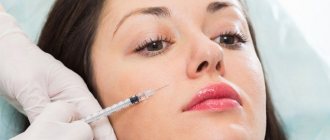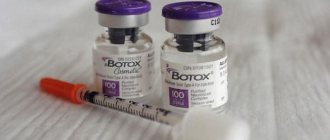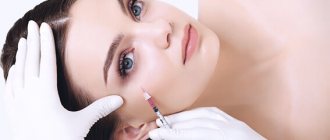At what age and how often can plasma therapy be done?
The most common question from patients is: at what age can the procedure be used? Cosmetologists recommend blood plasma therapy based on indications . If there are serious problems on the skin in the form of pimples and acne, then the age may be quite early - 15 years. As for facial rejuvenation, it is advisable to resort to this method of rejuvenation after 30 years, when the aging process begins to intensify.
The question of how often plasma therapy should be done can be answered this way: for maximum effect, treatment is carried out 2 times a year.
How many sessions are needed to complete the course?
Injections are carried out with a short time interval, the full course of plasma lifting consists of 4-8 procedures depending on the condition of the skin.
Benefits of plasma therapy
The technique of autologous cellular rejuvenation is quite young, but its advantages are obvious.
Collagen, elastin, hyaluronic acid and other building elements of skin cells are produced by the body itself, and are not introduced from the outside.
Since the patient is injected with his own plasma, the likelihood of allergic reactions and side effects is minimized.
Rejuvenation is not visual, “facade” in nature, but actually occurs from the inside, due to the activation of local immunity and regenerative processes. The effect of the procedure lasts up to 2 years, after which it can be repeated. It has a wide range of effects and is used as a rehabilitation and treatment program.
Although plasma injections cannot be called a comfortable manipulation - after all, these are multiple injections - it is much less painful than conventional mesotherapy. The relative painlessness of the procedure is achieved due to the neutral acid-base balance of the blood and its biocompatibility.
What are the techniques for performing plasma therapy?
There are several technologies that involve injecting blood plasma under the patient’s skin for rejuvenation and treatment. Let's look at the most common ones.
Swiss technique RegenLab
The technique developed in Switzerland is significantly different; it has a double effect.
Thanks to this, wrinkles and folds on the skin are filled in the shortest possible time, and only then does the activation of internal metabolic processes begin, which trigger the production of collagen and elastin. Thanks to this technique, overall skin rejuvenation has excellent results that can last up to two years . This is autologous rejuvenation at the cellular level during which not only plasma with a large number of platelets, but also autogel with thrombins is injected under the patient’s skin. Both of these substances are obtained from the patient’s blood, which virtually eliminates side effects, rejection and allergies.
Spanish technology
- Special equipment is used that allows plasma to be produced with a minimum number of platelet membrane ruptures. The activator is added to the drug directly in the patient's skin.
- This technique allows you to isolate plasma enriched with platelets, the number of which is individual for each patient.
The cosmetologist himself decides what concentration of plasma to use, based on the condition of the patient’s skin. - Endoret technology completely frees the plasma of leukocytes, which completely eliminates inflammation after injections. At the same time, the rehabilitation period is reduced to a minimum and is much easier.
- But the main difference between this technique is that a growth factor is introduced into the plasma, which helps to accelerate the launch of the skin’s own rejuvenation processes.
But it is worth remembering that the plasma lifting procedure is not cheap , so if you see a very tempting offer for such a procedure, then you should refuse and look for a clinic with more realistic prices for plasma lifting.
Laser and hardware method
This is a combination of plasma injections and hardware facial care. The procedure is carried out in two stages:
- The patient is injected with plasma obtained from his own blood.
- After this procedure, the skin is additionally treated with laser.
During this treatment, the old layer of the epidermis evaporates, thereby removing wrinkles, pigmentation and sagging. After using the laser, the skin becomes smooth and pink. At the same time, the rehabilitation period after plasma lifting is reduced to three days.
Already on the second day, small crusts form at the injection sites, which peel off by the 3rd day.
The result of the procedure is not inferior to a surgical facelift , with a short rehabilitation period.
Plasma transfusion
The plasmapheresis procedure can be performed by two main methods: discrete and hardware. As a result, doctors can prepare several types of plasma for subsequent transfusion:
- Native plasma
, which is isolated from donor canned blood. Thus, from 500 ml of preserved blood, 250–300 ml of native plasma are obtained. - Plasma obtained by automatic plasmapheresis
using a special installation.
For transfusion, fresh frozen plasma of the same blood group is used. Initially, doctors adhere to a dosage of 10–20 ml/kg. The decision on subsequent transfusions is made based on the patient’s clinical condition and the results of blood coagulation studies. However, do not underestimate the importance of blood plasma.
Plasma transfusion - indications and contraindications
Like any medical procedure, plasma transfusion has its indications and contraindications. Doctors always take them into account before prescribing a transfusion of hemostatic solutions. Among the situations when a blood plasma transfusion may be required, the indications include the following:
- Replenishment of the volume of plasma hemostasis factors in DIC complicated by the development of shock.
- Replenishing the volume of plasma hemostasis factors in acute massive blood loss.
- Reduced synthesis of plasma coagulation factors caused by liver diseases.
- Overdose of direct anticoagulants.
- Plasmapheresis for thrombocytopenic purpura, severe poisoning, sepsis.
- Coagulopathy caused by a deficiency of plasma physiological anticoagulants.
Plasmapheresis is not recommended:
- as a replenishment of blood volume;
- for parenteral nutrition;
- persons with a burdened transfusion history;
- with congestive heart failure.
Blood plasma transfusion - side effects
When prescribing such a procedure, doctors know the dangers of plasma transfusion, so they take appropriate measures to prevent complications. Among the common transfusion complications it is necessary to highlight:
- febrile non-hemolytic reactions;
- acute hemolytic reaction caused by AB0 incompatibility;
- overload of the circulatory system;
- allergic reactions;
- post-transfusion purpura;
- infections.
Process description
Let's consider the process of plasma therapy.
When is the best time to do it?
The procedure can be performed at any time when defects are observed on the skin. For rejuvenation, it is better to use it after 30 years, when the first facial wrinkles appear and the aging process is activated.
As for women with aging and sagging skin, plasma lifting is prescribed in conjunction with other anti-aging procedures , or the plasma is enriched with hyaluronic acid - the effect comes faster and lasts much longer.
How to choose and prepare?
Syringe and needle
To carry out the plasma therapy procedure, you need special equipment, test tubes and syringes.
The syringe must be sterile; as for the needle, specialists often use special double-sided elements, or “butterfly” needles.
also use needles that are designed for administering meso-cocktails . They are used in conjunction with a three-component syringe and a specialized butterfly catheter.
These instruments significantly facilitate not only blood sampling, but also the administration of the drug with minimal trauma to the facial skin. Butterfly needles are used with a special device for a syringe; they must be disposable and sterile with a silicone coating.
Test tube
Test tubes for plasma lifting are products made of heat-resistant glass filled with heparin or flaxiparin.
The tubes are sealed and completely sterile. Blood is taken directly into it, while the gel filler helps preserve all the useful components of the blood. At the same time, the quality of the intake material is maintained even during storage .
Centrifuge
In cosmetology clinics, a special device is used to centrifuge blood - a low-frequency laboratory medical centrifuge “Armed 80-2s”. The characteristics of this device are ideally suited for autoplasma therapy, supplying high-quality plasma separation, thus performing physiological and non-hazardous blood manipulation.
The centrifuge is small in size and simple, comfortable to operate. In case of malfunctions, the unit motor is mechanically switched off and the rotor is immediately stopped.
Place on the body
Before you go for a plasma therapy procedure, you need to understand how the skin is prepared. To prepare the skin for the procedure you need :
- Visit a cosmetologist and get a detailed consultation to identify contraindications and decide which areas will need to be worked on in the first session.
- In 2-3 days you need to increase your fluid intake; in most cases it is recommended to consume at least 2-25 liters of water per day.
You also need to exclude physical activity for the same time.- The procedure is performed on an empty stomach, so it is often prescribed in the morning.
- On the eve of the procedure, they begin to eat with the exception of fatty and spicy foods; you should not drink coffee or alcohol.
- Depending on the individual characteristics of the skin, a specialist may recommend special preparation for a specific program.
- Before the procedure, the patient is sent for a blood test.
Amount of blood taken
How much blood must be taken from the patient to give an injection appropriate to the procedure? In this case, everything is individual. The minimum amount of blood is 20 ml.
Sometimes, at the first visit to plasma lifting, a specialist may decide to take 40 ml.
But in any case, the amount of blood taken should not exceed 100 ml .
Step-by-step injection protocol
Let's look at how the introduction is made. The injection technique in a cosmetology clinic is as follows:
- make-up is removed, the face is washed, treated with a special antiseptic composition and an anesthetic gel is applied;
- blood is drawn;
- the test tube with the component is placed in a machine in which the blood is separated and no platelets are released;
- then plasma enriched with platelets and gel is drawn into a sterile syringe and injected under the patient’s skin;
- after administration, the face is treated again and dried with paper napkins;
- After this, a soothing gel is applied.
The procedure with all preparations lasts for an hour . Some patients, when they come home after plasma lifting, are disappointed because they do not see immediate results. Do not despair, as the effect of plasma injection will become noticeable only on the 10th day. The drug needs time to start metabolic processes in the skin.
We invite you to watch a video about the plasma lifting procedure:
Blood plasma donation
To avoid numerous reactions on the part of the body receiving blood, and to quickly replenish blood volume, doctors perform plasma transfusions. Plasma donation is a complex procedure that consists of 3-4 cycles lasting 30-40 minutes. First, a blood sample is taken from the donor, which is examined for the absence of infection or viruses. After this, the automated donation procedure itself is carried out directly:
- 350 ml of blood is taken from the patient.
- The resulting blood is separated in a special bell to obtain plasma in a volume of 230 ml.
- Cellular elements are returned back to the general bloodstream.
These steps are repeated by the automatic installation 3-4 times until plasma is obtained in a volume of 600 ml. After the procedure is completed, the donor is injected with 500 ml of saline, which stimulates the rapid restoration of the total plasma volume. The separated plasma is placed in a quick freezer, where it is cooled to a temperature of –30 degrees over several hours. With the help of shock freezing, it is possible to preserve plasma substances from decomposition, which allows preserving the blood clotting process.
Briefly about post-session care
In the period after the procedure, rehabilitation begins, during which it is impossible:
- Visit baths, solariums and saunas. Take a hot bath or shower.
- It is better not to touch the tits that may appear at the injection sites and not to treat them with anything - they will go away on their own.
- Avoid physical therapy.
- Do not drink coffee and eliminate alcohol.
- Touching your face for 2-3 days, even washing your face is prohibited, not to mention decorative cosmetics.
Preparation for plasma injections
Although the use of plasma in cosmetology is one of the most environmentally friendly methods, it is necessary to prepare for a course of procedures. You need to visit a therapist 2-3 weeks in advance and make sure there are no contraindications.
You will need to take the following tests:
- General and biochemical blood tests.
- Blood test for infections - hepatitis, HIV, RW.
Before carrying out plasma lifting, it is advisable to carry out detoxification and drainage procedures.
5-7 days before the start of the course you need to give up alcohol and caffeine. It is better to perform the procedure on an empty stomach. If it is scheduled for the second half of the day, a light breakfast is allowed, excluding fatty, spicy, smoked and fried foods.
Possible side effects
It is worth immediately noting that allergies to the procedure are very rare, but they are not excluded . For example, a patient may have an allergic reaction to Heparin, which is added to the blood to prevent it from clotting when processed in a centrifuge.
Hematomas and severe swelling may appear, or during the procedure a third-party infection will be introduced under the skin - only you can eliminate these troubles by correctly and responsibly choosing the clinic where plasma lifting will take place.
Side effects occur in most cases when the plasma injection technology is violated or due to the inexperience of the cosmetologist.
Composition and functions of blood plasma
As mentioned above, blood plasma consists mainly of water in which proteins and mineral compounds are dissolved. Their presence and concentration directly determine the physicochemical properties and characteristics of the plasma and its functions. When the composition of blood plasma changes, this leads to the development of pathological conditions, so the body itself constantly monitors the constancy of this environment.
If we talk about the main functions that plasma itself performs, they do not differ from those of blood, since these two substances exist inextricably in the body. The following functions of blood plasma are distinguished:
:
- transport;
- excretory;
- humoral;
- protective;
- homeostasis;
- thermoregulatory;
- pressure balancing;
- binding of extravascular fluids.
Blood plasma proteins and their functions
The structure of plasma is usually divided into two large components:
- proteins;
- non-protein structures.
Proteins themselves represent an important part of plasma. Among the variety of protein structures in plasma are the following:
- Low molecular weight albumins
- up to 5% of all proteins. There are α1-globulins, α2-globulins, β-globulin and G-globulin. - Large molecular.
They make up 3% of the total mass of proteins. Fibrinogens make up 0.4% of the total mass of proteins.
Each of these structures performs a specific function in the body:
- albumin in the blood – is involved in the delivery of various components;
- α – activate the process of protein synthesis, participate in the transport of hormones, microelements, lipids;
- β – take part in the transport of cations of iron, zinc, phospholipids, bile sterols, steroid hormones;
- G – contain antibodies necessary for the normal functioning of the immune system;
- fibrinogens - take an active part in the functioning of the blood coagulation system and have a direct effect on blood clotting processes.
Non-protein organic components of plasma
All non-protein structures and components of blood plasma are conventionally divided into two large groups:
- Group 1 – substances containing nitrogen.
They contain up to 50% urea nitrogen, 25% amino acid nitrogen, the remaining 25% are peptides, creatinine, bilirubin and indican. An increase in the concentration of these structures in the body accompanies kidney pathology and is also observed in burns. - Group 2 – represented by organic nitrogen-free substances.
Among them: lipids, carbohydrates, metabolic products, mineral elements of the blood.
Contraindications
- taking antibiotics;
- autoimmune diseases (diseases of the immune system);
allergy to anticoagulants;- blood diseases;
- hepatitis;
- oncological diseases;
- menstrual cycle;
- hypofibrinogenemia;
- infectious diseases;
- platelet dysfunction;
- exacerbation of chronic diseases;
- pregnancy;
- lactation period.
How does the procedure work?
Venous blood in the amount of 40-50 ml is taken from the patient and placed in a test tube with an anticoagulant and separation gel.
The blood is then separated in a centrifuge. It is divided into the following fractions:
- top: platelet-poor plasma (PRP);
- middle: platelet-rich plasma (PRP);
- below - red blood cells and leukocytes.
Reference. Anticoagulants are drugs that prevent blood clotting and the formation of blood clots.
The skin in the affected areas is treated with an antiseptic and topical anesthetic (pain-relieving cream), and then injections of platelet-rich plasma are performed.
After the manipulation is completed, the disinfectant is reapplied. Then healing agents with the addition of PRP are applied.
The amount of blood that is taken from the patient to perform hemorejuvenation is insignificant; the body simply “does not notice” this loss. A woman loses approximately the same amount in one day of menstruation. Therefore, some patients' concerns about increased blood loss are completely unfounded.
You can evaluate how effective the procedure was 2 weeks after it was performed. The full course ranges from 3 to 7 sessions.
Recommendations after plasma therapy
After performing plasma injections, it is necessary to protect the skin from exposure to ultraviolet radiation, water and mechanical stress.
During the week you cannot:
- sunbathe in the sun and in a solarium;
- visit the swimming pool, bathhouse, sauna;
- Do massage;
- perform cosmetic procedures.
Plasma injections into the face and neck may leave minor bruises that go away on their own fairly quickly.
During the plasma lifting course and for two weeks after, it is necessary to use sunscreen when going outside. This is especially true in summer, regardless of sunny or cloudy weather.
What problems does plasma lifting solve?
The range of application of this rejuvenation technique is quite wide. With its help, you can not only improve the condition of your facial skin, but also stop the process of hair loss, make it thicker and more beautiful, and also improve the condition of the skin in various parts of the body (body plasma lifting). Facial plasma therapy is especially effective in combating the first signs of skin aging. The plasmolifting procedure is suitable for those who want to improve their complexion, get rid of dry skin and increase its tone, remove fine wrinkles and bruises under the eyes and around the lips, and reduce expression wrinkles on the forehead.
Plasmolifting of the neck and décolleté can significantly rejuvenate the skin in these areas, moisturize it and make it less flabby. This procedure will also be effective in the fight against stretch marks in the décolleté area that appear after lactation.
This procedure is also good for those who have a cosmetic problem such as scars or acne scars. Plasmolifting significantly improves the appearance of deep and old scars on the face and body. After plasmolifting, the face will become even and smooth, acne scars will become less noticeable, and due to the fact that the procedure increases the skin’s own immunity, new rashes will not appear.
Plasmolifting under the eyes gives excellent results and is an effective way to rejuvenate the skin in this area, reduce bruises and bags under the eyes, and make fine wrinkles less noticeable.
Plasmolifting of the abdomen will help restore the elasticity of the skin of this part of the body, as well as improve the condition of the skin if there are stretch marks on it. The same effect can be achieved for the skin of the arms, hands, and thighs.
The effect of the procedure can be assessed from the photos before and after plasma lifting:
Plasmolifting sessions will also help those who are struggling with hair loss; the procedures help stimulate hair growth and increase thickness.
But clients who are planning to undergo this procedure must understand that in order to remove severely sagging skin, tighten the oval of the face and cope with other significant changes in appearance, plasma lifting is not a very effective procedure. These tasks can be better handled by other methods, such as bio-reinforcement of the face, thread lifting, etc. Plasmolifting shows good results in the fight against the first signs of skin aging; rejuvenating procedures usually begin with it; More serious methods can be used as needed.
Results of plasma therapy
The use of platelet plasma allows you to get a natural face lift without surgery. The skin becomes elastic, moisturized, and pink. The intensity of acne is reduced, shallow scars are smoothed, and the skin texture is evened out.
Patients who underwent this procedure noted that as a result, they visually “threw off” at least 5 years.
The procedure has a prolonged effect - the process of rejuvenation and increased collagen production continues even after the course of procedures. If cosmetic treatment with blood plasma is performed annually, you can significantly slow down the aging process and prolong youth for many years without resorting to plastic surgery and other highly invasive techniques.
The difference between plasma and gas:
Plasma is a kind of gas derivative obtained by its ionization. However, they have certain differences.
First of all, this is the presence of electrical conductivity. For an ordinary gas (for example, air), it tends to zero. Most gases are good insulators until exposed to additional influences. Plasma is an excellent conductor.
Due to the extremely small electric field, the plasma substance is dependent on magnetic fields, which is not typical for gases. This leads to filamentation and delamination. And the predominance of electric and magnetic forces over gravitational ones creates the collective effects of internal collisions of particles in matter.
In gases, the constituent particles are identical. Their thermal movement is carried out over short distances due to gravitational attraction. The structure of plasma consists of electrons, ions and neutral particles, different in their charge and independent of each other. They may have different speeds and temperatures. The result is waves and instability.
The interaction of components in gases is two-particle (very rarely three-particle). In plasma it is collective: the close arrangement of particles makes it possible for all groups to interact at once and with everyone.
When particles collide in gases, the velocities of molecular motion are distributed according to Maxwell's theory. According to her, only a few of them have relatively high levels. In plasma, such motion occurs under the influence of electric fields, and it is not only Maxwellian. Often the presence of high velocities leads to two-temperature distributions and the appearance of runaway electrons.
Smooth mathematical functions and a probabilistic approach are not suitable for an exhaustive description of the fourth state. Therefore, several mathematical models are used (usually at least three). Typically these are fluid, liquid and Particle-In-Cell (particle-in-cell method). But the information obtained even in this way is incomplete and requires further clarification.











